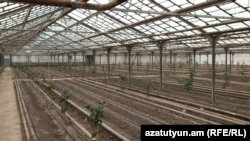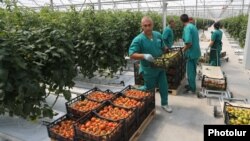Greenhouse owners in Armenia have warned that rising prices of electricity and natural gas will further push up the cost of their agricultural produce and could also drive many of them out of business.
Armenian utility regulators raised the electricity prices by an average of about 10 percent in December. The steepest price hike (12 percent) was set for businesses.
The retail prices of gas are widely expect to go up on April 1, less than two years after the Public Services Regulatory Commission (PSRC) raised the gas tariff for corporate consumers by roughly 4.5 percent.
Greenhouses, which now account for a sizable share of fruits and vegetables grown in Armenia, are especially reliant on gas and electricity in winter months. Their owners say that they will struggle to remain afloat after the upcoming price hike.
“If gas becomes more expensive, we won’t burn it anymore [for heating purposes.] Let people buy stuff grown abroad,” said Samvel Harutiunian, a farmer from Hovtashat, a village in Armenia’s southern Ararat province.
Harutiunian, who built his greenhouse more than a decade ago, said that he already had trouble operating at a profit last year.
“We’ll have to think about leaving this country or doing something else here,” he told RFE/RL’s Armenian Service. “We can’t do agricultural work anymore.”
According to Poghos Gevorgian, the head of the Armenian Greenhouse Association, natural gas accounts for at least half of the production costs incurred by farmers like Harutiunian.
“People already don’t have money to buy [greenhouse output,] and so greenhouses are now collapsing little by little,” said Poghosian.
Greenhouse farming in Armenia has expanded rapidly since the early 2000s, making it the most dynamic segment of domestic agriculture still dominated by subsistence farming. Greenhouses were built across the country not only by village but also large export-orient companies.
The Armenian government is now facing growing calls to shore up the greenhouse industry in the face of the rising energy costs. Economy Minister Vahan Kerobian said last month that the government is helping farmers offset the price hikes with higher productivity. But he did not elaborate.
The Ministry of Economy said on Friday that it will not to comment on the impact of a higher gas price until the utility regulators make a “final decision” next month.
Razmik Hambarchian, a farmer who owns a 2-hectare greenhouse in another Ararat village, Ghukasavan, said he will raise the prices of his vegetables by around 15 percent if gas does become more expensive. He said he has already laid off some of his workers and switched to new crops in response to the increased living costs.
“Electricity, water and food have become more expensive,” complained Hambarchian. “What can we do? Rise up? If we rise up, where should we go? To Paris or Berlin? Things have become more expensive all over the world.”
According to official statistics, food prices in Armenia soared by an average of almost 13 percent last year, reflecting a global trend. They pushed up overall inflation to 7.7 percent, the highest rate in many years.






